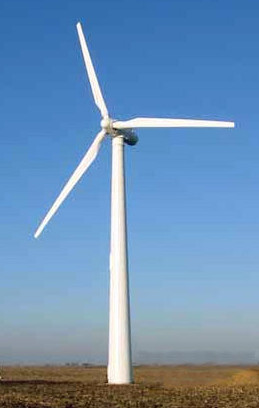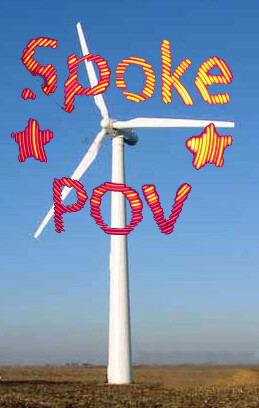Windmill POV
Feb
10
2015
In the interest of combining things (“leveraging technology” if you want the appropriate buzzwords), I thought through how wind turbines could sell advertisements.
By “wind turbines” I am referring to the tall, 3-vaned, modern-looking windmills that generate electricity (and kill birds) and are popping up in more and more places.
In fact, my niece plays soccer in the shadows of a few of these.

Now for the advertisements. If you’re not familiar with the concept of Persistence of Vision, here’s an example:
It refers to something that moves and blinks lights at such a rate that your eyes see those blinks as moving pixels.
If you put a line of lights on the windmill blades, and flashed them on at certain points, you would have a giant display board – the size of the swept area of the windmill blades.
But the refresh rate would be too slow. Current giant wind turbines operate at most 20 rpm, which equates to 1 rps (or 1 fps in display terminology). It’s 1 rps because there are 3 blades on these windmills, so 1 revolution is 3 refreshes of the display).
Movies operate at 24 fps, and television operates at 30 fps. That seems to be the minimum for good video.
But we don’t necessarily want good video – we’ll accept bad video quality for the initial product. So let’s cut the minimum frame rate of 24 fps in half to 12 frames per second. A rate of 12 fps means the windmill is turning at 4 rps or 240 rpm.
That is highly unrealistic.
For you structural engineers out there: can you imagine an 80-meter diameter windmill turning at 240 rpm?
Now the fun part: all the side effects and implications of having a typical utility-scale wind turbine spin at 240 rpm.
- Max rotational speed of 20 rpm at a max wind speed of 25 m/s (56 mph) implies that it would take a wind speed of 675 mph. That’s mach 0.9. Of wind.
-
Now we’re interested in the tip speed. So, translate the rotational speed into linear speed at the ends of the blades.
Most wind turbines have a diameter in the 50-90 meter range. Let’s assume blades on the larger side – a diameter of 80 meters (or a diafoot of 240).
240 feet of diameter = 750 feet circumference
750 feet * 4 = 3000 feet per second
3000 feet per second = 2045 mph
2045 mph = mach 2.7So the wind turbine blades would break the sound barrier.
-
And speaking of sound, how much noise would that wind turbine generate?
I found a chart that graphed noise versus tip speed.
At a tip speed of 40 m/s, the noise was 93 dbA.
At a tip speed of 100 m/s, the noise was 112 dbA.
This is a slope of 19 dbA over 60 m/s, or 0.3166666 dbA/m/s
The top tip speed of 2045 mph is about 900 m/s.
The equation is (900 – 100) * 0.316666 + 112.
Final result: 365 dbAI think that’s not possible.
It would damage not only your ears, but other things too.
-
And how long would the windmill last, assuming the blades and structure could be built to withstand the extra stresses with a similar reliability and durability with today’s use and materials?
Current expected lifetime of a windmill is 100 million revolutions.
At that rate, and 20 rpm, the windmill will last for
100,000,000 / 4 = 25 million minutes = 416,666.6666 hours = 17361 days = 47.5 years
100,000,000 / 4 rps = 25 million seconds = 6944 hours = 289 days = 0.79 years
I’ll leave it as an exercise for the reader to compute the stresses on the blades.
Also, bonus points for anyone who can calculate the change in atmospheric pressure for a noise of 365 dbA. Hint: convert dbA sound pressure level to pascals.
Any other aspects of windmill blades that should be mentioned?

P.S. For a still image, not video, LED-based POV seems to require 3 fps. So if you want a static billboard, apply a factor of 4 to all the calculations. Not as impressive (the blades no longer break the sound barrier), but still difficult. The main difficulty would be getting a constant 170 mph wind to drive the windmill.
P.P.S. Don’t count out the POV display idea for horizontal-axis wind turbine generators. I suspect it could be accomplished by stringing extra lights between the blades – on thin wires so as to provide minimal disruption to airflow.
Daniel [a]said, “I was looking in my vision by night, and behold, the four winds of heaven were stirring up the great sea.
Daniel 7:2




This little article thingy was written by Some Guy sometime around 6:32 am and has been carefully placed in the Technical category.

 This is Alpha, the first-born, when he was 2YO.
This is Alpha, the first-born, when he was 2YO. This is Beta, the second-born, when he was about 2YO.
This is Beta, the second-born, when he was about 2YO. This is Gamma, the third-born, when he was about 18MO.
This is Gamma, the third-born, when he was about 18MO.


